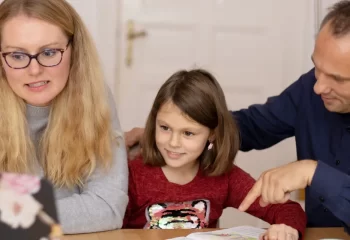Flexible Curriculum Basics
We’ve already learned about the basics of Flexible Teaching. Flexible Schooling requires teachers that are ready to embrace change – such as a flexible teaching schedule, or different flexible teaching strategies in order to offer students a personalized learning experience with a focus on their learning needs.
But what is a Flexible Curriculum and how does it improve learning in high school? Stay with us and we’ll find out together!
What is a Flexible Curriculum?
In schools with a flexible curriculum, things are not about changing the subjects to fit the students’ needs. Instead, they involve a shift in how teachers teach the subjects, making them more adaptable and personalized for the learning needs of their students.
A flexible curriculum also means that students do not have to worry about taking all 15+ subjects that public schools require. Instead, they can create an individualized learning path where they study exactly the subjects that match their interests and future ambitions.
In a rapidly evolving world, students cannot thrive by studying a curriculum designed decades ago. At Spark Hybrid High School, we believe in preparing students for the future through a modern and flexible curriculum that fosters future-ready skills and development.
Benefits
Among the benefits of a flexible curriculum we can mention:
- Space for curiosity – Students do not have to become A-level students in subjects that have no connection to their interests. Instead, they can explore their interests and curiosities and study what they like.
- Focus on Skill Development – Instead of traditional teaching methods, the teachers try to use different, modern approaches in the classroom that will not only help students learn information in their subjects but also skills they can later use in real life.
- Future-ready subjects – While the traditional curriculum contains subjects that some might consider necessary, it lacks in courses that should be taught given the rapidly changing technology. Here, Spark School comes in to save the day by offering a handful of subjects like Information Technology, Media Studies, Computer Science, etc. to students looking for advancement in these fields.
- Limitless flexibility – While this benefit lies in the title, we mainly refer here to the possibilities of numerous teaching methods that stir away from the traditional ones. At Spark, flipped learning is encouraged and we know that learning doesn’t only mean reading and memorising things.
Be that work experience opportunities, participating in camps, or project-based learning, these are just a few of the alternative learning methods that are all part of a teacher’s plan when teaching by a flexible curriculum. Obviously, we have lots of different teachers and teaching techniques tailored to our students’ needs, but you’ll have to come and try them out at Spark.
Limitations
For a school to be able to successfully implement a flexible curriculum, they also need the right teachers.
The right teacher doesn’t get chosen only on the basis of their knowledge or experience but with a great focus on their flexibility. We also have a blog post on flexible teacher qualities that could enhance one’s experience in dealing with rapidly changing environments.
As for other limitations, if we keep looking at the teachers, we also need to note that they need to be media literate – meaning embrace digitalization.
On a different note, if we are to analyze the situation from a student’s perspective, they need to know what their interests are in order for a curriculum like this to be useful to them. They get the chance to choose what they want to invest their time and energy in.
However, these decisions should be considered and documented beforehand in order to have the biggest positive impact on a student’s educational journey.
The Principle of Flexibility in the Curriculum
The principle of curriculum flexibility refers to a strategy that respects and embraces students’ different needs, learning styles, and interests.
It emphasizes the curriculum’s adaptability to individual students, allowing for personalized learning experiences. This idea recognizes that each student has different talents, limitations, and preferences and that the curriculum should be adaptable enough to meet those needs.
Educators are encouraged to create a more inclusive and student-centred learning environment by adding flexibility to the curriculum. This enables them to adjust their educational approaches, rhythm, and content to meet the requirements of individual students.
The flexibility principle promotes the use of a variety of educational strategies, technologies, and resources to engage students and foster deeper understanding and skill development.
Examples Of A Flexible Curriculum
There are several examples of a flexible curriculum that demonstrate the diverse approaches to personalized learning and adaptable instruction. Here are a few examples:
Personalized Learning Paths
A flexible curriculum may contain personalized learning paths that are adapted to the requirements and interests of individual students. Students may choose from a variety of courses, projects, or learning modules based on their talents, professional aspirations, or areas of interest. This method empowers students to take charge of their education and proceed at their own speed.
Project-Based Learning
A flexible curriculum that encourages hands-on, experiential learning is project-based learning. Students work on real-world projects, investigations, or challenges, putting their knowledge and abilities to use to solve issues or create something valuable. This method promotes collaboration, critical thinking, and creativity while giving students choices and autonomy in their learning.
Blended learning
This is a combination of traditional live instruction and online or digital materials. It provides students with freedom by giving them access to instructional resources, interactive activities, and evaluations via digital platforms. Students can study at their own pace, repeat ideas as needed, and receive personalized feedback with this technique.
Individualized Instruction
We can include individualized instruction in a flexible curriculum, where teachers customize their teaching methods, content, and assessments to match the specific learning needs of each student. This method includes ongoing evaluations, formative feedback, and focused interventions to address students’ strengths and areas for improvement.
Ways To Differentiate Curriculum
There are certain aspects that we can look at if we want to distinguish between a traditional curriculum and a flexible one:
Structure
A traditional curriculum is often structured and strict, with pre-defined topics and concepts taught in an orderly manner. Whereas at a high school teaching a flexible curriculum, students can take the courses that will help them meet their goals and nail university admission.
Uniform Pace
In a traditional curriculum, all students proceed through the curriculum at the same rate. At a flexible high school, students can proceed through the curriculum at their own pace, with assistance from a tutor wherever it’s needed.
Limited Choices
A traditional curriculum often offers limited choices for students in terms of elective courses or areas of specialization. It focuses more on core subjects. Flexible schools, on the other hand, place more emphasis on finding courses tailored around future-ready areas of interest.
Rigid Vs Flexible Curriculum
Rigid Curriculum
- Standardized and fixed structure
- Prescribes a precise order and sequence of subjects and topics
- Progression is consistent, with every student progressing at the same rate
- Students have limited choices, with many of them focused on essential topics
- Teacher-centred instructions and consistent assessments
Flexible Curriculum
- Customization and personalization are possible
- Allows for course selection, learning paths, and pace
- Also allows students to grow at their own pace while addressing various learning demands
- Provides students with options and chances to pursue their interests
- Encourages student-centred education, diverse assessments, and a variety of learning opportunities
Flexible Curriculum FAQ
What is the rigorous curriculum?
A rigorous curriculum refers to an educational program or set of courses that challenge students to think critically. It also requires them to analyze complex concepts and apply their knowledge in depth. They provide students with a high level of academic rigour and intellectual engagement.
What is a cohesive curriculum?
A cohesive curriculum is an educational framework that promotes a seamless progression of learning across various subjects or grade levels. It ensures that there is alignment, integration, and continuity in the content, skills, and concepts taught throughout the curriculum.
How can a curriculum be flexible?
A curriculum can be made flexible by allowing students to select courses based on their interests. Individualized pacing enables students to progress at their own speed, with additional support as needed. Differentiated instruction tailors teaching methods and assessments to meet diverse student needs.
What is a flexible approach to teaching?
A flexible approach to teaching involves adapting teaching methods, and resources to meet the diverse needs of students. It allows teachers to be responsive to individual learning styles, abilities, and interests. It can include teaching using varied teaching techniques and using technology.




